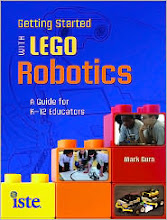(

_________________________ ( coolest-gadgets.com )From NY Times:
Led by Robots, Roaches Abandon Instincts
"Many a mother has said, with a sigh, “If your friends jumped off a cliff, would you jump, too?”
The answer, for cockroaches at least, may well be yes. Researchers using robotic roaches were able to persuade real cockroaches to do things that their instincts told them were not the best idea.
This experiment in bug peer pressure combined entomology, robotics and the study of ways that complex and even intelligent patterns can arise from simple behavior. Animal behavior research shows that swarms working together can prosper where individuals might fail, and robotics researchers have been experimenting with simple robots that, together, act a little like a swarm.
“We decided to join the two approaches,” said José Halloy, a biology researcher at the Free University of Brussels and lead author of a paper describing the research in today’s issue of the journal Science..."
Also see piece from Coolest Gadgets below:
"I have this absolute hate and fear of cockroaches, so it is with trepidation that I approach this Bandai-sourced robot which was modeled after real cockroaches. It comes with half a dozen legs and a touch sensor that tells the robot to change its directions whenever it bumps into a wall. A micro monitor embedded within enables it to vibrate just like a cellphone, while a microphone will detect loud noises, making it scurry away like the scum it is. If a cockroach is not your cup of tea, there is always another house-friendly model such as the ladybug. Known as the Hex Bug, this cockroach-inspired creation from Bandai will retail for approximately $15 a pop and will be released sometime in the middle of September..."













